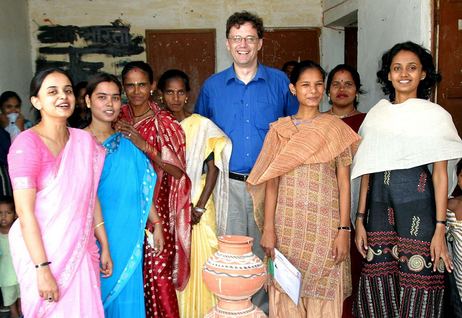ReadingWise - A Highly Effective Literacy Program for Developing and Developed Countries
Victor Lyons , United Kingdom My experience of 3rd world poverty is that most of the problems can be solved IF you can provide vocational training so people can get jobs, but you can't train people who are functionally illiterate. Two thirds of people in South Asia are functionally illiterate. But also a significant percentage of people in the US and the UK are functionally illiterate. 40% of the people in the US prison system are reportedly functionally illiterate, for example.
My experience of 3rd world poverty is that most of the problems can be solved IF you can provide vocational training so people can get jobs, but you can't train people who are functionally illiterate. Two thirds of people in South Asia are functionally illiterate. But also a significant percentage of people in the US and the UK are functionally illiterate. 40% of the people in the US prison system are reportedly functionally illiterate, for example. In India, we came up with a literacy solution that worked. We developed a program called Tara Akshar in Hindi (and ReadingWise in English). We have proved we can get people who have never been to school to read and write in a 55 hour course. We'd like to export it to the rest of the world, including the US and the UK.
My background is in counselling/psychotherapy (specialising in traumatic memories) and I.T. (specialising in e-learning). E-learning is the reverse of PTSD therapy. In e-learning you are trying to get memories to stick. In PTSD therapy, you are trying to get memories to unstick. I'm British, but I've worked in the US, the UK and India.
In 2001, I walked out on my dotcom company in Miami, and then looked around to do something useful. I went to work with my friends who run an NGO called Development Alternatives in India. I wanted to find out if there was anything one individual could do about endemic poverty. The answer is that there certainly is!
I found that the illiteracy rate was about twice as bad as the official Government figures. Officially one third of India is illiterate. If you define literacy as being able to read and write well enough to study a very simple manual so you can get a semi-skilled job – functionally literate – then two thirds of India is illiterate. That’s 700 million people. I think it’s the worst un-reported human tragedy in the world. An illiterate person in rural India is forever trapped in a subsistence condition with no hope for the future.
So we looked around for the best literacy program in India. Amazingly, there wasn’t one that had any credibility. The official government one had never been properly monitored for effectiveness. Of course, this explains why the country still had 700 million functional illiterates.
So we set about writing a literacy program from scratch. As I’d had extensive training in both mental health and in e-Learning systems in IT, I was able to work from first principles to build an IT application that was going to work. Our target was a program that would teach basic reading and writing in one month at maximum of two hours a day. We felt that anything longer would bring a danger of the high drop-out rates that beset other literacy programs. After all, we were dealing with people who had never been to school, and we expected incessant distractions from their families pulling them away from daily study.
Nobody in the world (as far as I know) has ever developed a 30 day literacy program. But we were building one from scratch, using first principles. We used a barrage of memory techniques to help the students remember what sounds goes with what letter. We used video gaming techniques in our software to reinforce the learning.
We spent two years building the program. It combined cartoon animations, computerized testing, flash cards and posters. “We” was myself and my team of 4. We built prototype after prototype, went out to the villages to try it out, then come back to the office and rework it. Eventually we set up our first formal class, trained our trainers, finalized the exams, printed the certificates. The first graduation ceremony was extraordinary. We had made 18 women literate in 34 days at 100 minutes a day. It worked! One lady, who a few weeks earlier had been completely illiterate, stood up, grabbed the microphone and READ OUT A POEM THAT SHE HAD WRITTEN.
After that, there was no stopping us. We got money from DfID, the Britsh Government’s development department, as well as Oxfam and Microsoft and other people, and set up 300 literacy centres across rural India, all equipped with laptops and trained instructors.
Over the next two and half years, we made 57,000 women literate. (Yes, all women, the men don't seem interested.)
The next step was to get the Indian Government interested. After all, it’s the government’s failure to set up decent primary schools and decent teachers that has brought about this mess. Historically, the Indian Minister of Education is not usually the brightest spark in the cabinet, but now all that has changed. The current Minister is very impressive indeed. So we have been doing pilots to prove to the government that our program works and should be fully adopted as the solution of choice to make the 700 million illiterates literate. We have just finished the initial pilots, which have shown exceptional results. We now hope that the Government will fully adopt our program, because this is India’s best hope for solving its staggeringly huge poverty program.
A keynote of the program is its extremely low drop-out rate, and its effectiveness with remedial learners.
And yes, we have lots more clever training programs ready for our newly-literate graduates so we can get them the skills needed to get the jobs that will take them out of poverty.
I am now keen to run our literacy program in other countries. We are developing versions in other languages including English and Arabic. I see no reason why the whole world shouldn’t learn to read by this method.
If anyone wants our help with setting up a literacy program in any language anywhere in the world, including the US, let me know.
Victor Lyons, London
ReadingWise Ltd
Tel +44 203 489 5179
[email protected]
Next Story »

